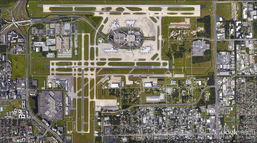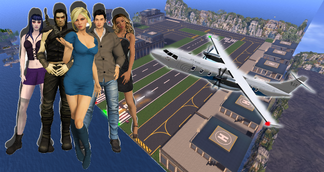
This page is created with the idea of helping the owners of airports in the construction and design of an airport, to provide information to the general public about everything related to the structures, buildings and component parts; we give the information about what is seen in SL (inworld) and can be found in the real world; also other information about the aviation in SL, devices, air navigation and links to marketplace where you can get many of these things (free or paid) will be given.
New airport owners
In Second Life Aviation wiki we have some tips about runway signs and other things, what you need know for you have a good airport, and we are happy to help you; here is some tips and links for this:
Airport: size, LDA and types
- Size: region or "sim" (short for simulator) has a size of 256 meters and an airport of this size is already a big airport (currently, there are airports of two and more sims, but that is not normal ); the minimum size for a small airfield where aircraft landing type Cessna would be 64 m long and 32 m wide (1/4 x 1/8 sim) and we could say that nothing more would be for private use; of course, the larger the ground, the more chances we have to put more things, being a good size than 1/2 x 1/4 sim (128 x 64 m); see this examples:
- LDA: or the Landing Distance Available of a runway, which is what a runway measures in its entirety; As you can see in the graph, the LDA tells us how short is the space to brake in that particular runway, being the braking distance called LDR (Landing Distance Required), almost 80% of the LDA; in SL, if you have a runway of 200m LDA, the LDR distance is 160m for a smooth landing (if you find lag when entering the airport sim it is almost impossible). In the case of airstrips with a runway of 60 or 70 meters LDA, we practically have to brake (put the trottle in reverse) almost since we entered.
- Types: we can find basically three types of structures which can be constructed airports:
- at the height of the terrain: in this case land base is kept, leaving her flat without bumps to avoid tripping the plane, or it becomes a solid platform above the ground simulating an asphalt structure; see this examples:
- a platform: it is an elevated structure that stands on pillars at its ends, and which is often used when a marina was built under the airport; also is widely used when you want to put next to a high mountain; see this examples:
- an skyport: a simple platform is placed in the sky, usually between 200-3000 meters, can take a whole sim or very small; many owners prefer to put their airport in the sky because there are many nearby lands with ban lines or objects that hinder a good air traffic; see this examples:
Runway: numbers
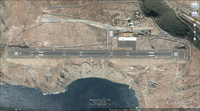
- Single runway/cardinal point: the numbers that are on a runway when landing or taking off always give rise to confusion and doubt, and nearly 40% of airports or more are misplaced, so I give a brief and simple directions as they get. Usually, what we see are the numbers related to the four cardinal points (north: 36, east: 09, South: 18, West: 27); in this case, we are at the head of the runway, as if we were to take off, look at the compass or the mini map, and the number that we see has to match that of the runway (eg 270 in the compass, 27 on the runway); at the other end of the runway must be the opposite number (example: 27/09, 36/18).
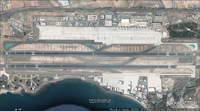
- Dual runway/cardinal point: when there is two parallel runways (one for takeoff and one for landing), usually put the runway number and a letter indicating if left (L) or right (R), for example 27L / 27R; usually, you land on the left side (eg 27L) and takeoff on the left side of the other end of the runway (eg 09L); anyway, each airport owner brand which side you want to be taking off or landing, especially knowing that in SL airports sizes are small (one sim or region has only 256 x 256 meters), depending on the aircraft size a certain width of runway is required (normal is 10 meters wide, but not everyone can have a runway of these dimensions).
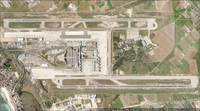
- Single or dual runway/not cardinal point: depending of the size of the airport, the owner can change the arrangement of the runway, leaving this off the beaten disposal; in these cases reshapes the numbering from ten to ten degress (eg: a runway oriented at 128 degress on one side, and the other end to 308 degress, would be marked 13 on one side and 31 on the other side); It thus indicates when the final number is between six and zero (126 degress correspond to the number of runway 13, and 148 degress correspond to the number of runway 15), but if the final number is between one and five would look like (124 degress = number 12 and 143 degress = number 14); we must pay attention to these cases, using the runway itself as a compass and looking in edit mode degress indicated; to know which is the opposite number of the runway just have to add (or subtract) 180 according this (eg 126 degress one side and the other side 126 + 180 = 306, or even 258, where the other side would 258-180 = 78).
- Three or more runways: in real life, to an airport what matters most is the wind, its direction and its intensity, as well as a climate as stable as possible throughout the year; as that is impossible, they are often constructed in the direction the wind usually predominates, although that is also difficult; therefore, in a place with gusts of winds and changing, are often built several runways cross each other to take advantage of prevailing winds. In SL are usually build such runways just for the pleasure of seeing them from the air, or by the amount of land that is available, although it is usual that the arrangement of the photos you can see above; but we are only interested in the way in which the marks are made on the runway, that is: we know how are marked if two (L / R), indicating that if they are three run parallel, the center is indicated by the letter C (center); in the case of not parallel runways that are they are shown only with numbers provided, according to the who are degress (24, 16, 22); in the following photos several examples (left Roosevelt Roads Naval Base, the center Cúcuta airport and right Tampa International airport).
Runway: lights, devices, marks and signs
ATTENTION: always we must put all objects in phantom mode to prevent accidents.
- Approach lights: these lights are very important when going to landing, and we indicate the proximity of the runway; the draw distance who we have put on the graphics preferences make us see more soon (or not) these lights, because due to the time it takes to create the objects when we approach, is most likely a good landing if we marked drawing distance to 256 meters (or more) of our destiny; in SL do not all have the possibility to have a good PC, with high quality graphics card, a lot of gigas intended into RAM memory, and an internet connection of more than 50 megas; therefore, something that is very important when flying is this draw distance (with good equipment, usually we put it at 300 meters, but with a normal equipment we put a minimum 128 meters). Then a series of photos of the various models of lights shows in some airports of SL:
- Devices:
- the VASI and the PAPI indicators are very important (the explanation given on pages vendor about this equipment is very complete and I will not extend into the details about these instruments).
- this Airport Approach Light device has a system for check when an aircraft go to takeoff, and send a message to main device for turn on the red warning lights in front off the runway head, and if an aircraft try landing the lights warn for abort the landing; in the case of the lights are in white warn all the aircraft it can landing.
- the runway and taxi lights is other importtant device for our airport.
- Marks and signs: marks and signs found in the runway, the taxiway and the tarmac are another important element and are not put in a random way, but rather with a particular protocol, adjusted to the airport size; i put here a link for a webpage with more info about this.
Buildings
The airport complements are very important for a realistic touch in our airport; i put here some links to builders experts in this (if you need some special device, only put the name in the search box, i see incredible articles of low cost or free there):
- R.S. Airport Electrical Services (Roger Schwager)
- Flywalker Aviation Outfittters (LukeFlywalker Fittinger)
- StrykerJ Builds (Stryker Jenkins)
- Ananda Ghost: free items
I built my airport: and now what?
Once built our aerodrome, airfield, skyport or airport, we have to ask a very important question: my airport is public or private?
- In the case of private, we closed it with ban lines or with a security bot who kick ass and send home in 5 seconds; and to make it more clear, we put in the information of our land who is a private airport and we do not want to put on any list or to be known by anyone.
- Or, we can make it public (and put a rez area) and let everybody enjoy it (and if we put a few hangars, some that another vendor and create a group where they pay for membership, we can win some money).
Well, let's assume that you are a boy or a girl enterprising, willing to take risks and maintain a monthly rent for a whole sim, for example (almost $ 200, € 180 or £ 125) and also want have open your airport for more than two months ... Congratulations !, you just enter the most competitive team of SL entrepreneurs.
The next steps are:
- Create a chat group for internal communication with the name of our airport, and so to have direct communication with our partners, tenants, vendors and friends.
- Partnering with several groups with common interests, in this case aviation, such as the following:
- Communicate opening to members of SL Air / Sea Mapping Authority, and wait to come to our airport a member of this group, and activated it in the map of Kelly Shergood; from this point, we have two options:
- a member of this group make to us our airport ICAO code (the best option)
- or, ourselves, select it from this airport list (we have wait for the administrator say if not occupied by another airport, or if available).
- Contact with the administrators of Second Life Aviation Wiki to come to upgrade our airport, take pictures and create our own page; when is created, we can by own update with more information; It is convenient we register as a member of the wiki to prevent others unregistered people put false information.
- If we are going to close our airport, we have to communicate both to the administrator of SL Aviation wiki, as managers of the map; if the closure is temporary, indicate for how long it is to reserve the ICAO code; if the closure is definitive, indicate this also to make available to other users the ICAO code.
- And finally, some recommendations that may be of interest; you have to read a little, but are a very interesting articles.
Old airport owners
In SL Aviation wiki we need know if you make changes in your airport, or if you closed it, for update correct of the airports information. And if you close your airport for a time (and you need reserve the ICAO code for other time), or if this closed is definitive (for put you code to other airport, if that is necessary).



